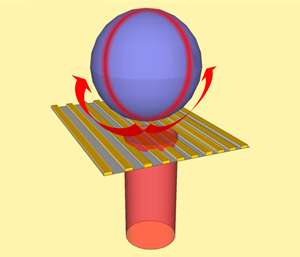Enhancing optical interactions in advanced photonic devices

Trapping light into a small volume is a useful way of amplifying optical effects. Optical cavities, for example, can enhance the interaction between light and matter. Incorporating these tiny structures into actual devices is difficult however, because they are easily broken or can become optically misaligned.
Xia Yu at the A*STAR Singapore Institute of Manufacturing Technology and co-workers have now developed an optical-fiber-based structure that harnesses the potential of light trapped in a microcavity. The novel design also provides a robust route to advanced devices for filtering and sensing light.
Yu and colleagues melted silica glass to form a sphere with a diameter of 182 micrometers. They then patterned the end of an optical fiber with a gold grating and held it close to the microsphere. The grating coupled light propagating along the fiber into the sphere (see image). Light with the right wavelength traveled around in circles within the sphere, trapped by the smooth silica–air interface. This confined light is known as a whispering-gallery resonant mode.
The A*STAR team investigated the properties of their structure by measuring the amount of light at each wavelength that managed to escape from the cavity back into the fiber. The typical wavelength-dependent response of a microsphere is a sharp, symmetric peak centered on the resonant wavelength of the cavity.
Instead, the researchers observed an asymmetric spectral peak, which they recognized as a clear signature of the so-called Fano effect, indicating strong interaction or interference between the whispering-gallery mode and the light in the fiber directly reflected back from the grating.
"This interfering effect makes Fano resonances especially sensitive to changes in either of the participating systems: a slight perturbation results in dramatic alteration in the optical characteristics," says Yu. "An obvious application of Fano resonance is for use in ultra-sensitive detection."
In previous investigations of the optical Fano effect, researchers inserted (and extracted) light into the cavity through the side of an optical fiber—an approach that proved unstable and inefficient. The method used by Yu and colleagues of directly inserting light into the cavity through the end of the fiber proved far more robust, making the technology a plausible platform for cheap and compact optical-resonator-based photonic devices.
Another possible application for the technology is as an optical switch. "A good switching device must be fast," explains Yu. "Therefore, the next step in our research will be to attempt to control the speed of the whispering-gallery mode Fano resonance."
More information: Zhou, Y., Zhu, D., Yu, X., Ding, W. & Luan, F. "Fano resonances in metallic grating coupled whispering gallery mode resonator." Applied Physics Letters 103, 151108 (2013). dx.doi.org/10.1063/1.4823531
Journal information: Applied Physics Letters



















